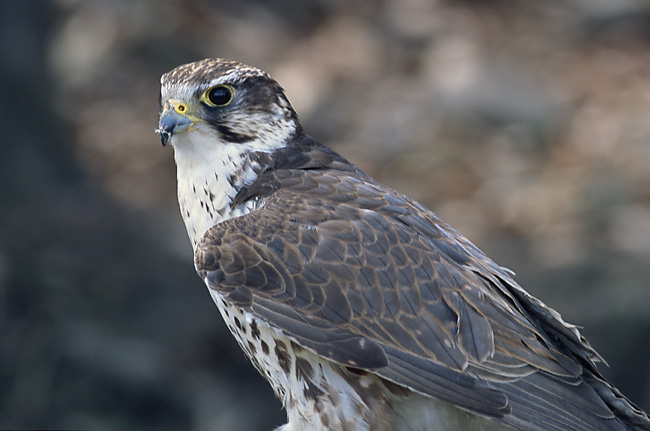|
| Query: falcon | Result: 4th of 587 | |
Saker Falcon (Falco cherrug) - Wiki
| Subject: | Saker Falcon (Falco cherrug) - Wiki
| |

| Resolution: 650x431
File Size: 85658 Bytes
Upload Date: 2007:12:05 16:43:03
|
Saker Falcon
From Wikipedia, the free encyclopedia
Order: Falconiformes
Family: Falconidae
[Photo] Saker Falcon (Falco cherrug). Author: Marek Szczepanek (http://commons.wikimedia.org/wiki/User:Pkuczynski/Marek_Szczepanek) Copyright (C) Marek Szczepanek
Permission is granted to copy, distribute and/or modify this document under the terms of the GNU Free Documentation License, Version 1.2 or any later version published by the Free Software Foundation; with no Invariant Sections, no Front-Cover Texts, and no Back-Cover Texts. A copy of the license is included in the section entitled "GNU Free Documentation License". |
The Saker Falcon (Falco cherrug) is a very large falcon. This species breeds from eastern Europe eastwards across Asia to Manchuria. It is mainly migratory except in the southernmost parts of its range, wintering in Ethiopia, the Arabian peninsula, northern India and western China. During the end of the last ice age - oxygen isotope stages 3-2, some 40,000 to 10,000 years ago -, it also occurred in Poland (Tomek & Boche??ski 2005).
Description and systematics
The Saker Falcon is a large hierofalcon, larger than the Lanner Falcon and almost as large as Gyrfalcon at 47-55cm length with a wingspan of 105-129cm. Its broad blunt wings give it a silhouette similar to Gyrfalcon, but its plumage is more similar to a Lanner Falcon's.
Saker Falcons have brown upperbellies and contrasting grey flight feathers. The head and underparts are paler brown, with streaking from the breast down. Males (called sakrets in falconry) and females are similar, as are young birds, although these tend to be a duller brown. The call is a sharp kiy-ee.
Adults can be distinguished from the similar Lanner Falcon since the Lanner is blue-grey above with a reddish back to the head. However, juveniles of the two species can be very similar although the Saker Falcon always has an uniformly buff top of the head with dark streaks, and a less clear pattern on the sides of the head.
A further complication is that some Asian birds have grey barred upperparts; these must be separated from Lanner on size, structure, and a weaker moustache stripe. Saker Falcons at the northeast edge of the range in the Altay Mountains are slightly larger, and darker and more heavily spotted on the underparts than other populations. These, known as the Altai Falcon, have been treated in the past either as a distinct species "Falco altaicus" or as a hybrid between Saker Falcon and Gyrfalcon, but modern opinion (e.g. Orta 1994) is to tentatively treat it as a form of Saker Falcon, until comprehensive studies of its population genetics and ecology are available.
Unfortunately, this species belongs to the close-knit hierofalcon complex. In this group, there is ample evidence for rampant hybridization and incomplete lineage sorting which confounds analyses of DNA sequence data to a massive extent; molecular studies with small sample sizes can simply not be expected to yield reliable conclusions in the entire hierofalcon group. The radiation of the entire living diversity of hierofalcons seems to have taken place in the Eemian interglacial at the start of the Late Pleistocene, a mere 130,000-115,000 years ago; the Saker Falcon represents a lineage that expanded out of northeastern Africa into the interior of southeastern Europe and Asia, by way of the eastern Mediterranean region.
Probably the saker falcon was the hungarian mythological bird, the Turul.
Ecology and status
The Saker Falcon is a bird of open grassland with some trees. It is a carnivore, usually hunting by horizontal pursuit, rather than the Peregrine's stoop from a height, and feeds mainly on rodents and more rarely birds. This species usually builds no nest of its own, but lays its 3-6 eggs on the ground or in an old stick nest in a tree which was previously used by other large birds such as crows, ravens or buzzards. However, it is known to have occasionally laid eggs in nests built on cliffs.
BirdLife International categorises this bird as endangered, due to a rapid population decline, particularly on the central Asian breeding grounds. The species faces pressure from both habitat loss and illegal capture for falconry. The population was estimated to be between 7,200 and 8,800 mature individuals in 2004. In the United States there are several captive breeding projects.
http://en.wikipedia.org/wiki/Saker_Falcon
| The text in this page is based on the copyrighted Wikipedia article shown in above URL. It is used under the GNU Free Documentation License. You may redistribute it, verbatim or modified, providing that you comply with the terms of the GFDL. |
|
Comments |
|---|
| | cialis france |
|
| 3UqHIt uzacoxkb yfyegjes olaidcnq |
| | Guest |
|
Scientific Name: Falco cherrug Gray, 1834
Common Names: Saker Falcon, Saker, Altai Falcon (“altaicus”)
French: Faucon sacre; German: Würgfalke; Spanish: Halcón sacre
Taxonomy: Falco cherrug J. E. Gray, 1834, India.
Synonyms: Falco lanarius |
^o^
Animal Pictures Archive for smart phones
^o^
|
|
|